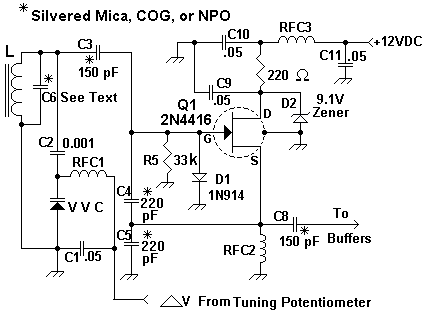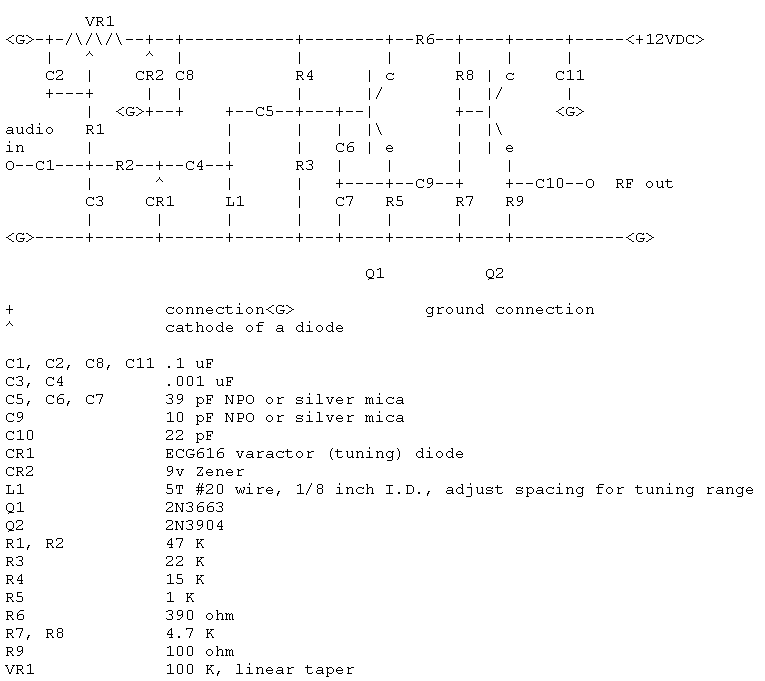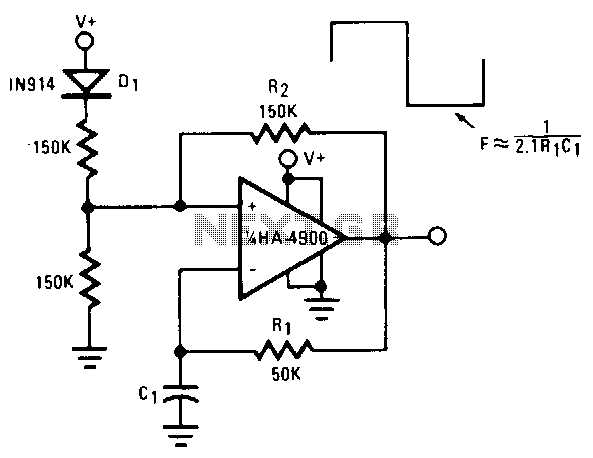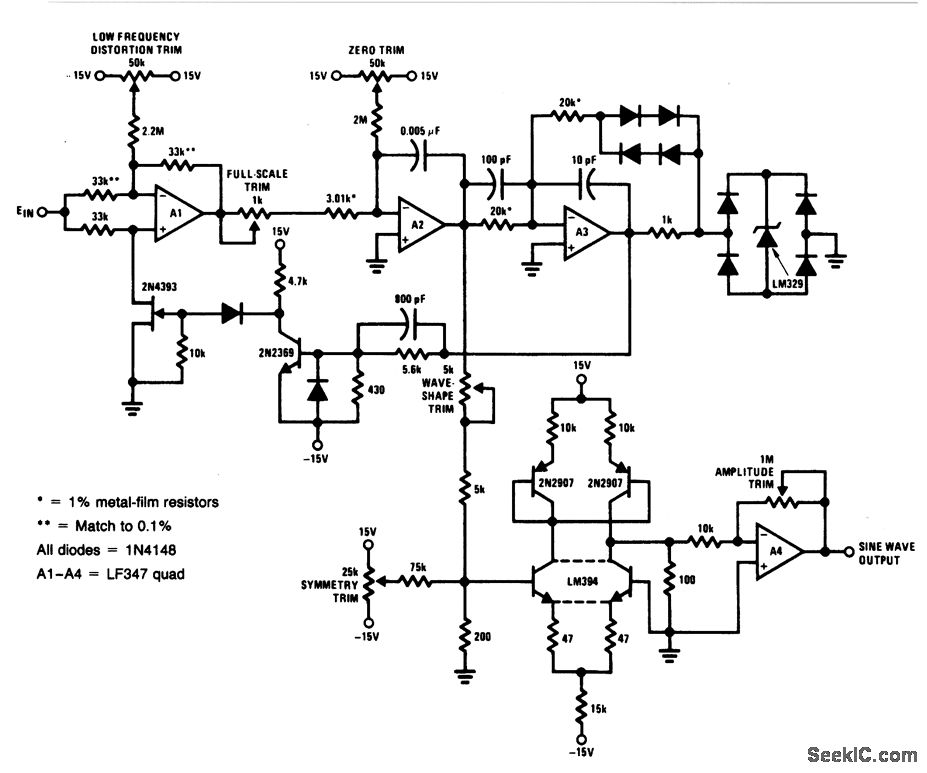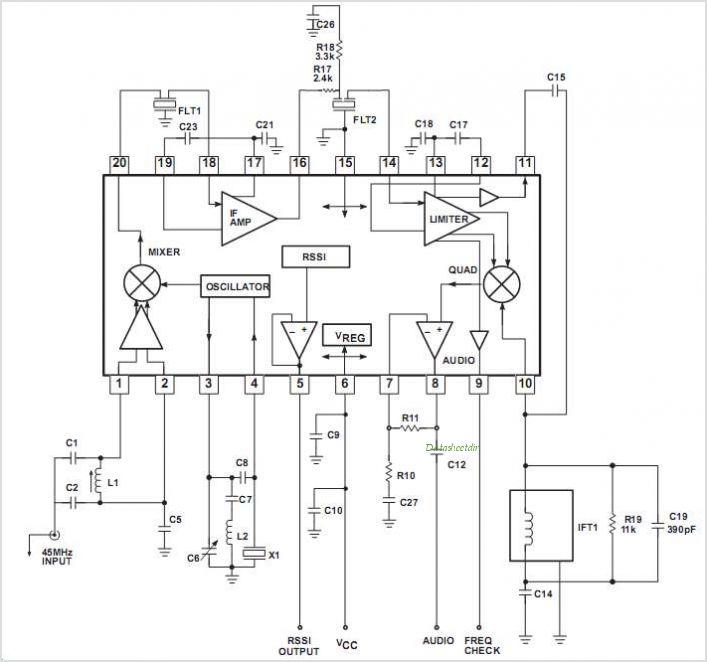
Low-voltage oscillator features increased spectral purity

A common issue in crystal sinusoidal oscillators is the excitation of unintended modes of the quartz crystal, which diminishes the spectral purity of the oscillator. This issue is particularly significant in overtone crystals, especially for low-voltage applications. In such cases, a trade-off exists between the transistor's operating point and the crystal's drive level. If the transistor's operating point results in a low current level in the crystal, it may not achieve the minimum energy required for proper vibration startup. The proposed circuit is a straightforward modification of a Colpitts oscillator, where the transistor's emitter is grounded through an inductor. The inductor L1 enhances the voltage gradient across the crystal plates during the transient response of the oscillator (after power is applied), aiding the startup of crystal vibration. A detailed analysis indicates that for overtone crystals, the impedance is inductive at the crystal's fundamental frequency, while it becomes capacitive at the desired overtone frequency. This allows for easier initiation of the desired overtone oscillation while avoiding interference from undesired fundamental frequency perturbations. Furthermore, the overall transfer function exhibits low-pass characteristics that suppress higher harmonics in the oscillator output. This circuit has been utilized in the creation of a 27-MHz oscillator for industrial communication applications. Without the proposed modification, 23% of the oscillators failed, with the failure rate showing a notable dependency on the production series (manufacturer reference) of the crystal. With the modification implemented, nearly all of the oscillators function correctly. Conversely, the total harmonic distortion (THD) of the oscillator, when L1 is substituted with a 4.7k resistor (as in a classical Colpitts oscillator), is 28%. With the proposed modification (inductor L1), the distortion is significantly reduced to 0.32%. All measurements were conducted with a power supply of 3.3 V.
The described circuit modification enhances the performance of crystal oscillators by addressing the critical issue of mode excitation in quartz crystals. The configuration of grounding the transistor's emitter through an inductor not only aids in overcoming low current levels but also optimizes the startup conditions for vibration. The inductor L1 plays a pivotal role in increasing the voltage gradient across the crystal plates, which is essential during the transient phase immediately following power application. By ensuring that the crystal can achieve the necessary energy levels for startup, the circuit effectively mitigates the risks associated with unwanted mode excitation.
In the context of overtone crystals, the analysis reveals a beneficial relationship between impedance characteristics and frequency. The shift from inductive to capacitive impedance as the frequency transitions from the fundamental to the overtone allows for a more stable and reliable oscillation at the desired frequency. Additionally, the low-pass behavior of the transfer function serves to filter out higher harmonics, resulting in a cleaner output signal.
The practical implications of this modification are significant, particularly in industrial communication applications where reliability and signal integrity are paramount. The marked reduction in failure rates from 23% to near-zero with the modification underscores its effectiveness. Moreover, the substantial decrease in total harmonic distortion from 28% to 0.32% illustrates a remarkable improvement in signal quality, making this circuit modification a valuable enhancement for crystal oscillator designs intended for low-voltage and high-performance applications.A common problem in crystal sinusoidal oscillators is the excitation of unwanted modes of the quartz crystal that degrade the spectral purity of the oscillator. This problem is significant in overtone crystals, particularly if the oscillator is intended for low-voltage applications.
In this case, there`s a compromise between the operating point of the transistor and the drive level of the crystal. If the operating point of the transistor produces a low current level in the crystal, it can`t reach the minimum energy for correct vibration startup. The proposed circuit is a simple modification of a Colpitts oscillator, in which the transistor`s emitter is grounded through an inductor ( see the figure ).
The inductor L1 increases the voltage gradient in crystal plates during the transient response of the oscillator (after power is applied), facilitating the crystal vibration startup. A detailed analysis reveals that, in overtone crystals, the impedance is inductive at the crystal fundamental frequency, whereas this impedance becomes capacitative at the desired overtone.
Therefore, the desired overtone oscillation will be easily started and the undesired fundamental frequency perturbations are avoided. In addition, the overall transfer function has a low-pass behavior that eliminates higher harmonics in the oscillator output.
This circuit has been used in the production of a 27-MHz oscillator for an industrial communication application. Without the proposed modification, 23% of the oscillators failed, with the failure rate noticeably dependent on the production series (manufacturer reference) of the crystal.
With the modification shown, practically all of the oscillators run correctly. On the other hand, the total harmonic distortion (THD) of the oscillator shown, when L1 is replaced by a 4. 7k resistor (classical Colpitts oscillator), is 28%. With the proposed modification (inductor L1), the distortion is reduced to 0. 32%. In all of these measurements, the power supply was 3. 3 V. 🔗 External reference
The described circuit modification enhances the performance of crystal oscillators by addressing the critical issue of mode excitation in quartz crystals. The configuration of grounding the transistor's emitter through an inductor not only aids in overcoming low current levels but also optimizes the startup conditions for vibration. The inductor L1 plays a pivotal role in increasing the voltage gradient across the crystal plates, which is essential during the transient phase immediately following power application. By ensuring that the crystal can achieve the necessary energy levels for startup, the circuit effectively mitigates the risks associated with unwanted mode excitation.
In the context of overtone crystals, the analysis reveals a beneficial relationship between impedance characteristics and frequency. The shift from inductive to capacitive impedance as the frequency transitions from the fundamental to the overtone allows for a more stable and reliable oscillation at the desired frequency. Additionally, the low-pass behavior of the transfer function serves to filter out higher harmonics, resulting in a cleaner output signal.
The practical implications of this modification are significant, particularly in industrial communication applications where reliability and signal integrity are paramount. The marked reduction in failure rates from 23% to near-zero with the modification underscores its effectiveness. Moreover, the substantial decrease in total harmonic distortion from 28% to 0.32% illustrates a remarkable improvement in signal quality, making this circuit modification a valuable enhancement for crystal oscillator designs intended for low-voltage and high-performance applications.A common problem in crystal sinusoidal oscillators is the excitation of unwanted modes of the quartz crystal that degrade the spectral purity of the oscillator. This problem is significant in overtone crystals, particularly if the oscillator is intended for low-voltage applications.
In this case, there`s a compromise between the operating point of the transistor and the drive level of the crystal. If the operating point of the transistor produces a low current level in the crystal, it can`t reach the minimum energy for correct vibration startup. The proposed circuit is a simple modification of a Colpitts oscillator, in which the transistor`s emitter is grounded through an inductor ( see the figure ).
The inductor L1 increases the voltage gradient in crystal plates during the transient response of the oscillator (after power is applied), facilitating the crystal vibration startup. A detailed analysis reveals that, in overtone crystals, the impedance is inductive at the crystal fundamental frequency, whereas this impedance becomes capacitative at the desired overtone.
Therefore, the desired overtone oscillation will be easily started and the undesired fundamental frequency perturbations are avoided. In addition, the overall transfer function has a low-pass behavior that eliminates higher harmonics in the oscillator output.
This circuit has been used in the production of a 27-MHz oscillator for an industrial communication application. Without the proposed modification, 23% of the oscillators failed, with the failure rate noticeably dependent on the production series (manufacturer reference) of the crystal.
With the modification shown, practically all of the oscillators run correctly. On the other hand, the total harmonic distortion (THD) of the oscillator shown, when L1 is replaced by a 4. 7k resistor (classical Colpitts oscillator), is 28%. With the proposed modification (inductor L1), the distortion is reduced to 0. 32%. In all of these measurements, the power supply was 3. 3 V. 🔗 External reference
